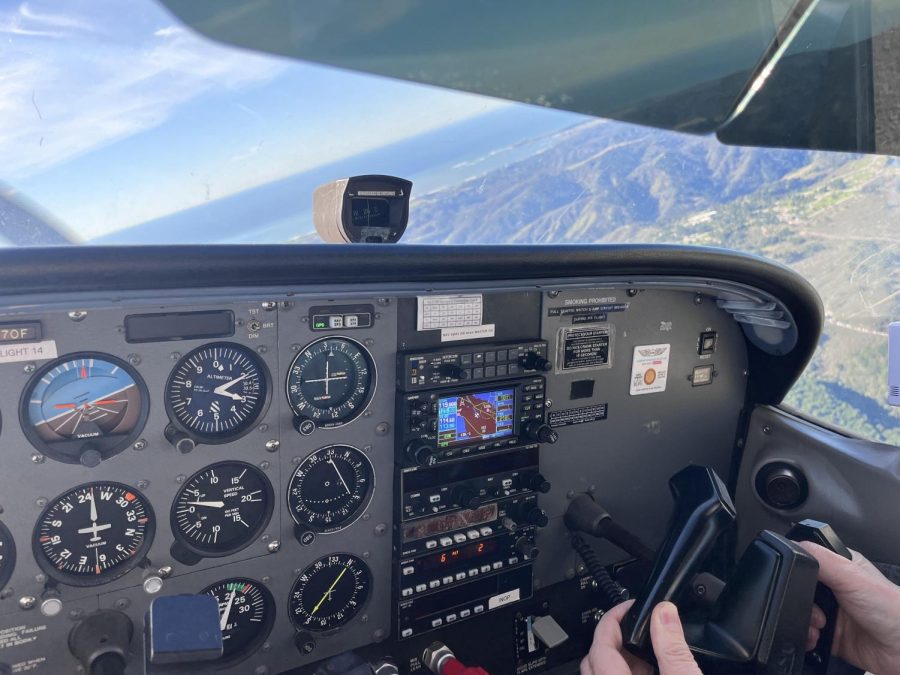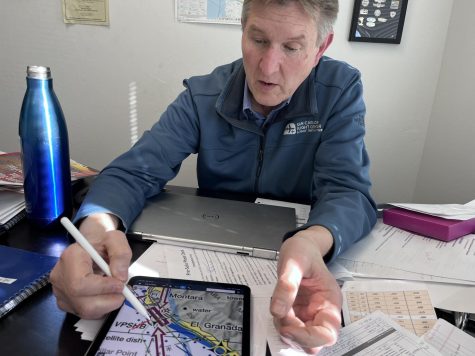
Twitter: @jono_scoop
March 2, 2023

For Patten and Dyer, transitioning from a pilot to a flight instructor wasn’t easy.
“I had to take many notes after each student’s lesson because I found myself forgetting everything as soon as the next lesson began,” Dyer said.
Patten could track his students’ progress, but finding a method to teach them correctly proved difficult.
“I think the biggest challenge was just understanding that I needed to let go of the plane so that the student could really learn. I think that’s always a hard thing to do. I learned in flight school how to do maneuvers, but they don’t teach you a little bit of the psychology you need to know to handle students,” Patten said.
Leaving the controls to students allows them to learn by doing, with the flight instructor guiding them. Although some topics are more challenging to teach than others; take the concept of risk management.
“Risk management would probably be the hardest to teach. To teach students to be able to make good decisions. It’s hard to teach that,” Patten said.
“The concept of risk and how to define it is probably one of the world’s most subjective subjects,” according to Davisson B in an AOPA Risk Management article.
Making learning conducive for each student, especially with more abstract concepts like risk management, is essential. To accomplish this, instructors must set up the proper environment for students to independently realize what they need to do.
“We can say, hey, these are the rules and regulations. But to learn the skills, you can set up an environment where they teach themselves,” Patten said.

For instructors, knowing how to teach is as important as knowing how to fly.
“The ability to explain complex topics is important. Knowing the most effective path to learn flying skills is crucial. And a positive attitude to help people accomplish their goals is necessary,” Dyer said.
Like Dyer, Shetty believes that the relationship and rapport between an instructor and a student is valuable.
“An instructor’s willingness to answer your questions and their ability to make themselves available makes them valuable when you learn to fly. When they are not really willing to answer those tricky questions, it makes flying a lot harder. There is a lot less trust there. I prefer a kind of trustworthy and open person,” Shetty said.
Flight school is a challenge, and the ability of an instructor to aid their student is vital in supporting their student’s experience.
“Flight training was relatively difficult for me because the students are responsible for a lot of new information. Understanding how the aircraft works and how you navigate airspace around you is tricky,” Shetty said.
“I think landing was a pretty tricky part of flight training because when you’re being taught to fly, the ground is where you’re supposed to stay away from,” Shetty said.
Students are not simply taught how to land. Rather, flight instructors aim to teach students by building their experience, as mentioned before. Patten applies this logic when conducting landings, stalls, and other maneuvers with students.
On average, Patten handled 2-3 students a day.
“I tended not to do more than that because I just feel like it’s just too much work; I really want to give quality versus quantity,” Patten said.
When handling students, Patten’s job would begin long before the lesson.
“I get up every morning to check the weather to see what’s going on. I review my notes from previous lessons and the activity for the students when they come in. Then on most days, I would do a certain amount of ground instruction with a student.”
While flying with students, Patten began to notice patterns of mistakes.

“I think many times I’ve seen a combination where students may just kind of overcontrol the plane rather than just let the plane fly by itself. And I think the other aspect is that sometimes students just don’t yet quite perceive what the plane is doing.”
Many students are used to driving, and adjusting them to a plane’s flight controls takes effort.
“I think the hardest thing to teach is that the hands don’t do the same thing in a plane that they do in a car: the feet now control the rudder, which controls yaw. It’s a new skill that is hard for people to learn,” Patten said.
To get his students accustomed to the new controls, Patten creates learning situations for his students.
“We set up the experiments for the students to learn. By going through that exercise, that skill, then the student usually teaches themself. We take students, go up to altitude, and we start having them observe what the plane is doing, and they realize that to make the plane fly correctly, they need to be using their feet as much or, in some cases, more than their hands,” Patten said.
As Patten puts it, he sets up a laboratory, considering things as extensive as the order in which he teaches.
“Order definitely matters; one skill will build onto another skill. We always say that our syllabus is very structured and built upon one another,” Patten said.
Flight instructors like Patten go through this process, all with the common goal of preparing their students for their check rides.
“There’s a lot of pressure on the instructor to ensure the student is prepared well, and often we over-prepare the student. It’s a gratifying feeling when at the end of the day, after their tests, the examiner says to the students, congratulations. You’re a pilot,” said Patten.
He has helped about a dozen students through training.
“Mostly private, some commercial, some instrument, and some instrument flight instructor students,” Patten said.
And outside of instructing, Patten would host events and learn from Dyer.
“Sometimes, I would do safety seminars. I would help if I could, you know, update our curriculum or exercises. I think I spent a lot of time with Dyer and just soaked up as much information as possible from him,” said Patten.
“Herb often created and presented seminars as part of our FAA Safety Seminar. He regularly volunteered to make the Flight Center a more social and educational place,” Dyer said.
Because Patten volunteered so much at the flight center, he became an Assistant Chief Pilot, part of the Chief Pilot Office. But around 2020, Dyer faced medical issues.
“I was no longer healthy enough to be a pilot. I still enjoy flying, but I can’t be the Pilot-in-Command. Instead, I fly with my friends,” Dyer said.
“He could no longer be a pilot. He decided to phase out (of the Flight Center), so we sold the business to Franco,” said Patten.
Franco took over after Dyer retired and is the current owner.
“When Dyer retired and moved out of the area, I bought the business from him so that the SCFC could be able to continue our high level of flight instruction,” Franco said.
In need of a new chief pilot, the flight center offered the job to Patten, who had been an assistant chief pilot for a year.
“It wasn’t necessarily something that I wanted to be. I’d prefer to be the person in the background, you know, helping things out and doing the work, whereas a chief pilot seems like I have to be more of a leader, managing the flight instructors. But I think I pretty much did it because I had so much interest in making sure that the flight center continued.”
So Patten accepted, and his job pivoted from managing students to managing instructors.
“There’s less one-on-one teaching. I spend probably like 30 or 40% of my time continuing to improve our training material. And the other aspect of it is trying to, you know, hire and train new instructors.”
Though Patten still flies with students. He is the last person student pilots fly with before they complete their solo flight.
“So in the average day as a chief pilot, I might have one flight a day, or perhaps two flights a day. And then the rest of the time is kind of like working on course material.”
